Tiền Thời Lê Văn Khôi
XXI.
The Nguy-khoi Rebellion. The Nung Rebellion. Doubtful Coins.
1600 to date.
The Nguy-khoi Rebellion.
KHOI was an officer of high rank in the employ of the
Government in Lower Cochinchina. he was accused of holding
ambitious views and of wishing to assert his independence, and
therefore was called to the court of Hue to give an account of
his actions. Afraid to appear, he raised the standard of
rebellion in the province of Saigon, and very soon became master
of the Mytho, Bien-hoa, Baria and Mo-xai districts.
King

 MINH-MANG became seriously alarmed at the proportions of this
rebellion, and sent troops by land and sea to quell it. The
royal army slowly regained possession of the disturbed
districts, with the exception of Saigon, which became the centre
of the insurrectionary movement, the inhabitants offering
serious resistance. The town was besieged, and had it not been
for the treachery of one of the rebel chiefs who opened the
gates of the citadel, the royal troops would have been kept in
check for a considerable time.
MINH-MANG became seriously alarmed at the proportions of this
rebellion, and sent troops by land and sea to quell it. The
royal army slowly regained possession of the disturbed
districts, with the exception of Saigon, which became the centre
of the insurrectionary movement, the inhabitants offering
serious resistance. The town was besieged, and had it not been
for the treachery of one of the rebel chiefs who opened the
gates of the citadel, the royal troops would have been kept in
check for a considerable time.
KHOI was made a prisoner, taken to Hue, and condemned to
death by being slowly cut to pieces. About the same time nearly
two thousand of his followers were put to the sword at Saigon
and were buried in the place known to this day as the field of
Graves.
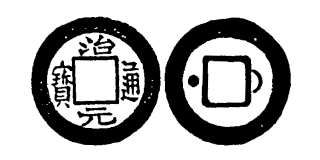
No. 240. - Obverse:



 Tri-nguyen-thong-bao
Tri-nguyen-thong-bao
Reverse: A crescent and a dot on the right and left of
the hole. Lead. Coin issued by Khoi (1831-1834).
The Nung Rebellion.
NUHG VAN-VAN was the feudal chief of the Bao-lac district.
who, availing himself of the insurrection in Tunquin of a
descendant of the
 LE Dynasty, followed his example by revolting in 1832, in the
provinces of [][] Tuyen-quang. [][] Cao-bang, [][] Lang-son, and
[][] Thai-nguyen. His fortunes were checkered, and although he
twice gained possession of the city of Cao-bang, on each
occasion he had soon to retire before the royal troops sent
against him.
LE Dynasty, followed his example by revolting in 1832, in the
provinces of [][] Tuyen-quang. [][] Cao-bang, [][] Lang-son, and
[][] Thai-nguyen. His fortunes were checkered, and although he
twice gained possession of the city of Cao-bang, on each
occasion he had soon to retire before the royal troops sent
against him.
For three years he kept the troops at bay in the mountains to
which he had fled, but having; suffered severe defeat at
Bao-lac, he found himself compelled to seek refuge in China. On
his arrival he was persecuted by the mandarins to whom the
Annamese had applied for his extradition, and fearing to be
caught, he re-entered Annam and tried to hide himself in the
An-quang-xa woods. He was discovered, however, by the Annamese,
who, fearing that he might again escape, surrounded the woods
and set fire to them. On the following day the charred body of
NUNG VAN-VAN was found near some rocks.
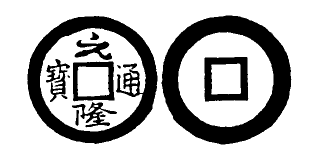
No. 241. - Obverse:



 Nguyen-long-thong-bao. The character
Nguyen-long-thong-bao. The character
 Nguyen written in the running hand style.
Nguyen written in the running hand style.
Reverse: plain. White copper.

No. 242. - Obverse: Same as before, but with
the four characters written in plain style.
Reverse: plain.

No. 243. - Obverse: Same as No. 241.
Reverse: with a double rim.
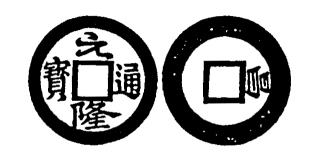
No. 244. - Obverse: Same as No.
241.
Reverse: The character
 Xuong, the meaning of which is uncertain.
Xuong, the meaning of which is uncertain.
Doubtful Coins. 1600 to date.
Having completed the classification of Annamese coins, there
still remain a number of cash bearing the names of Princes, of
rebel chiefs, or of various mints. Their Annamese origin is well
established, but owing to the want of precise information
regarding the history of the country, it has been found
impossible to place them under separate and distinct headings.
It has therefore been considered best to class tliem as doubtful
until the researches of others shall have supplied the means of
determining the respective periods to which they belong.
Among them there are doubtless many from the Quang-nam
Principality, the rulers of which were kings de facto and issued
coins at various times. But in making up the chronological
tables of the different Annamese dynasties, the name used by
these rulers in their own territory could not be traced, and it
has therefore been found impossible to classify the coins issued
by them.
The classification of other doubtful coins cast by certain
rebels presents still greater difficulties owing to the
shortness of time during which some of those chiefs were in
arms, and to the fact that the names under which they fought, or
the titles they assumed when in revolt, have not as a rule been
recorded to Annamese books.
The following is a list of these coins:

No. 245. - Obverse:



 Thieu-thanh-nguyen-bao.
Thieu-thanh-nguyen-bao.
Reverse: The character
 Chanh, the meaning of which has already been explained. Copper
mixed with tin.
Chanh, the meaning of which has already been explained. Copper
mixed with tin.
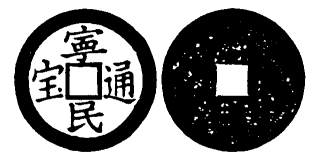
No. 246. - Obverse:



 Ninh-thi-thong-bao. The character
Ninh-thi-thong-bao. The character
 Bao, written in an abbreviated form.
Bao, written in an abbreviated form.
Reverse: without rim. Heavy coin made of white copper.
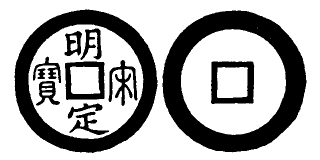
No. 247. - Obverse:



 Minh-dinh-tong-bao. The characters Tong-bao written in the seal
style.
Minh-dinh-tong-bao. The characters Tong-bao written in the seal
style.
Reverse: plain.
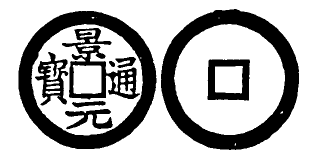
No. 248. - Obverse:



 Canh-nguyen-thong-bao.
Canh-nguyen-thong-bao.
Reverse: plain.
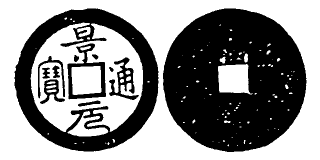
No. 249. - Obverse: Same as before, but written
in seal characters.
Reverse: without rim.
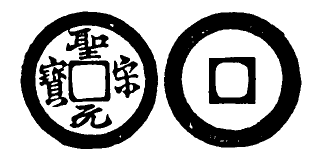
No. 250. - Obverse:



 Thanh-tong-nguyen-bao.
Thanh-tong-nguyen-bao.
Reverse: plain. Red and white copper.
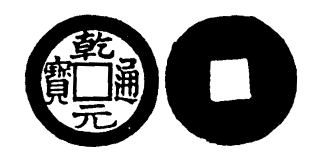
No. 251. - Obverse:



 Can-nguyen-thong-bao.
Can-nguyen-thong-bao.
Reverse: without rim. Red Copper. Seems to have been cast
in Upper Tunquin.
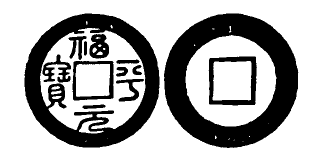
No. 252. - Obverse:



 Phuoc-binh-nguyen-bao. Written in seal characters.
Phuoc-binh-nguyen-bao. Written in seal characters.
Reverse: plain. Copper mixed with tin.
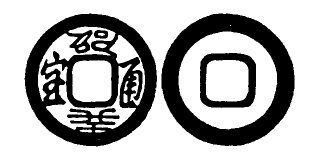
No. 253. - Obverse:



 Tieu-qui-thong-bao. Written in running hand and seal characters.
Tieu-qui-thong-bao. Written in running hand and seal characters.
Reverse: plain. Yellow copper.

No. 254. - Obverse:



 Thuong-nguyen-thong-bao.
Thuong-nguyen-thong-bao.
Reverse: without rim. White copper.
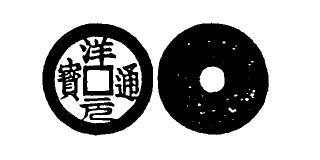
No. 255. - Same as before, but of smaller size. These
coins are very thin and of three or four different sizes.
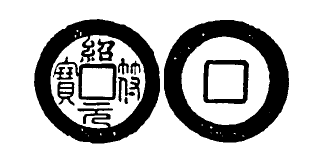
No. 256. - Obverse:



 Thieu-phu-nguyen-bao. Written in seal characters.
Thieu-phu-nguyen-bao. Written in seal characters.
Reverse: plain. Red copper.
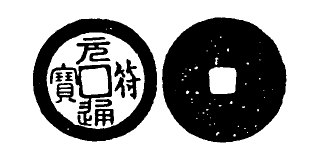
No. 257. - Obverse:



 Nguyen-phu-thong-bao. Written in seal characters.
Nguyen-phu-thong-bao. Written in seal characters.
Reverse: without rim. White copper.
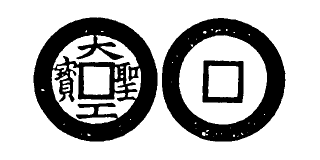
No. 258. - Obverse:



 Dai-coung-thanh-bao.
Dai-coung-thanh-bao.
Reverse: plain. Red copper.
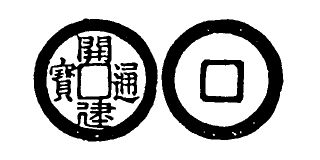
No. 259. - Obverse:



 Khai-kien-thong-bao.
Khai-kien-thong-bao.
Reverse: plain. Red copper.

No. 260. - Obverse:



 Sung-minh-thong-bao.
Sung-minh-thong-bao.
Reverse: plain.
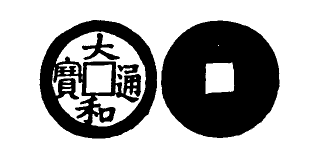
No. 261. - Obverse:



 Dai-hoa-thong-bao.
Dai-hoa-thong-bao.
Reverse: without rim.
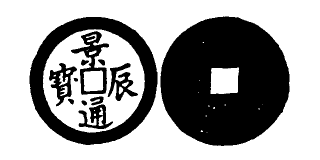
No. 262. - Obverse:



 Canh-ti-thong-bao.
Canh-ti-thong-bao.
Reverse: without rim.
Note: Second character looks more like
 Thinh.
Thinh.
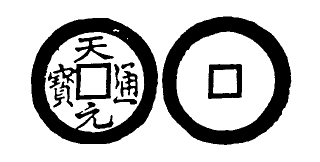
No. 263. - Obverse:



 Thien-nguyen-thong-bao.
Thien-nguyen-thong-bao.
Reverse: plain.
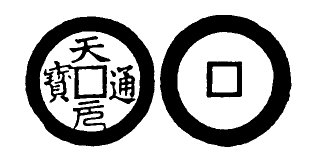
No. 264. - Same as before, but with the
character
 of the obverse written in the seal style.
of the obverse written in the seal style.

No. 265. - Obverse:



 Nguyen-tri-thong-bao. The characters tri and bao written in the
seal style.
Nguyen-tri-thong-bao. The characters tri and bao written in the
seal style.
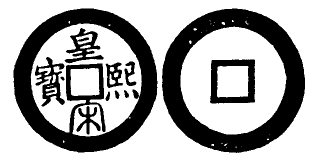
No. 266. - Obverse:



 Hoang-hi-tong-bao.
Hoang-hi-tong-bao.
Reverse: plain.
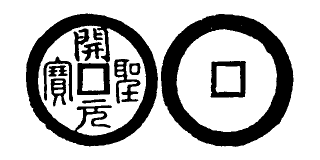
No. 267. - Obverse:



 Khai-thanh-nguyen-bao.
Khai-thanh-nguyen-bao.
Reverse: plain.
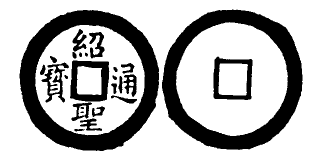
No. 268. - Obverse:



 Thieu-thanh-thong-bao.
Thieu-thanh-thong-bao.
Reverse: plain.
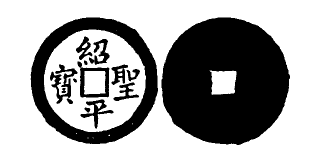
No. 269. - Obverse: Same as before,
bat with the character
 binh instead of
binh instead of
 thong.
thong.
Reverse: without rim.

No. 270. - Obverse:



 Thieu-tong-nguyen-bao.
Thieu-tong-nguyen-bao.
Reverse: without rim.
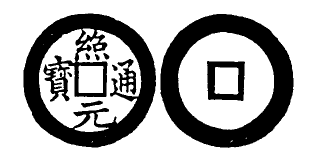
No. 271. - Obverse:



 Thieu-nguyen-thong-bao.
Thieu-nguyen-thong-bao.
Reverse: plain.
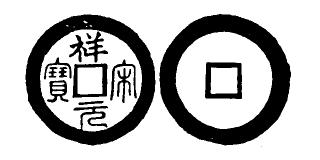
No. 272. - Obverse:



 Thuong-tong-nguyen-bao.
Thuong-tong-nguyen-bao.
Reverse: plain.
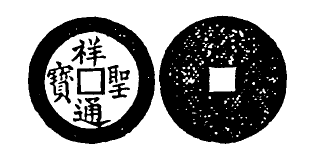
No. 273. - Obverse:



 Thuong-thanh-thong-bao.
Thuong-thanh-thong-bao.
Reverse: without rim.

No. 274. - Obverse:



 Hi-tong-nguyen-bao.
Hi-tong-nguyen-bao.
Reverse: plain.

No. 275. - Obverse:



 Ung-cam-nguyen-bao.
Ung-cam-nguyen-bao.
Reverse: without rim.

No. 276. - Obverse:



 Thong-phu-nguyen-bao.
Thong-phu-nguyen-bao.
Reverse: without rim.
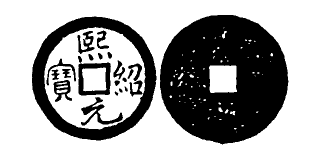
No. 277. - Obverse:



 Hi-thieu-nguyen-bao.
Hi-thieu-nguyen-bao.
Reverse: without rim.
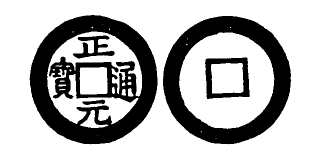
No. 278. - Obverse:



 Chanh-nguyen-thong-bao.
Chanh-nguyen-thong-bao.
Reverse: plain. Copper mixed with tin.

No. 279. - Obverse: Same as before.
Reverse: without rim.
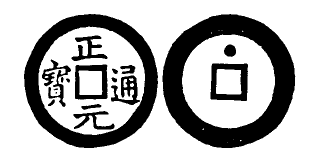
No. 280. - Obverse: Same as No. 278.
Reverse: A dot above the hole.
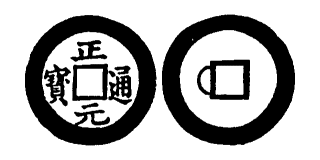
No. 281. - Obverse: Same as No. 278.
Reverse: A crescent on the left of the hole.
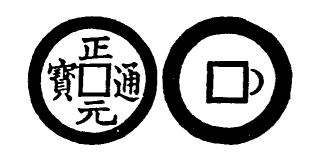
No. 282. - Obverse: Same as No. 278.
Reverse: A crescent on the right of the hole.
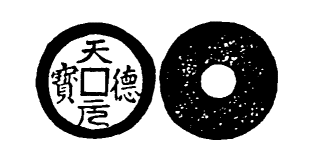
No. 283. - Obverse:



 Thien-duc-nguyen-bao.
Thien-duc-nguyen-bao.
Reverse: without rim.

No. 284. - Obverse:



 Hoang-ban-thong-bao.
Hoang-ban-thong-bao.
Reverse: plain.
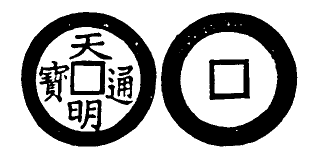
No. 285. - Obverse:



 Thien-minh-thong-bao.
Thien-minh-thong-bao.
Reverse: plain. Lead. Coin made in the Quang-nam
province.

No. 286. - Obverse:



 Thai-thanh-thong-bao.
Thai-thanh-thong-bao.
Reverse: without rim.
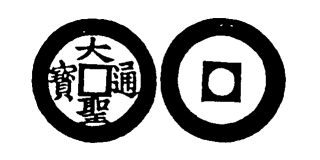
No. 287. - Obverse:



 Dai-thanh-thong-bao.
Dai-thanh-thong-bao.
Reverse: plain.
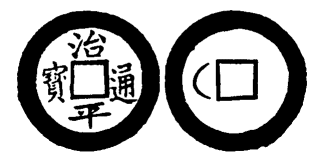
No. 288. - Obverse:



 Tri-binh-thong-bao.
Tri-binh-thong-bao.
Reverse: A crescent on the left of the hole.

No. 289. - Obverse:



 Chanh-hoa-thong-bao.
Chanh-hoa-thong-bao.
Reverse: A crescent on the right of the hole.
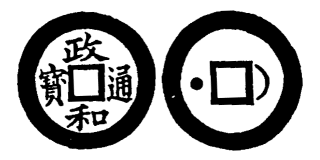
No. 290. - Obverse: Same as before.
Reverse: A crescent and dot on each side of the hole.
|